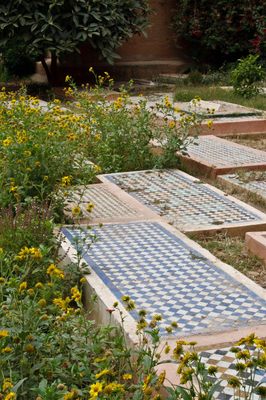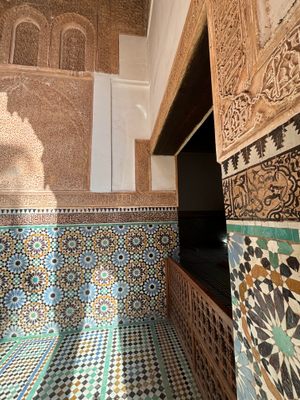About
The Saadian Tombs are a series of sepulchers and mausoleums in Marrakech that house the remains of important figures from the Saadi Dynasty, which ruled Morocco from 1549 to 1659. Shortly after the fall of the dynasty, the tombs were sealed off and hidden, only to be rediscovered in 1917.
The royal necropolis on which the Saadian Tombs were built was likely in use since the beginning of the 14th century. But it was during the reign of Ahmed el-Mansour, the Saadi Sultan from 1578 to 1603, that the tombs reached a far more prominent and lavish status.
Ahmed el-Mansour's father, Mohammed ash-Sheikh, was buried at the site after his murder in 1557. Not long after, Ahmed el-Mansour began to enlarge and embellish the entire burial ground, including the construction of two magnificent mausoleums for his father, his mother, his own descendants and, of course, himself.
His own mausoleum, the Hall of Twelve Columns, was built from imported Italian Carrara marble, with gilding honeycomb muqarnas, a type of ornamented vaulting, decorated with gold. He shares his mausoleum with some of his closest family members and descendents, including Princess Zorha, whose tomb carries the epitaph, “Here is the tomb of the noble lady, new moon, marvel of virtues.”
Between the two mausoleums and throughout the gardens lie many more tombs, including a prominent chamber for Ahmed el-Mansour's mother, Lalla Messaouda, who was buried in 1591. In total, 66 princes and other prominent figures lie in the Saadian Tombs, as well as more than 100 chancellors and wives, each resting closer to the Sultan's mausoleum depending on his or her status. These include the graves of a number of trusted Jewish advisers, some of who, judging by their location, were highly valued by the Sultan.
The very existence of the Saadian Tombs was placed in doubt with the end of the Saadi Dynasty. Less than two decades after the end of Saadian rule, along came a man who certainly deserves a brief digression. This man was Moulay Ismail ibn Sharif, the second ruler of the Moroccan Alaouite dynasty, who reigned from 1672 to 1727.
Moulay Ismail, variously known as the "Warrior King" and “The Bloodthirsty,” had a penchant for adorning his city walls with the heads of his victims, which totaled an estimated 30,000 during his rule. He also had a fondness for concubines, which numbered around 2,000, and multiple wives (including, incidentally, an Irishwoman named Mrs. Shaw). In between torturing laborers and beheading servants, he managed to father 867 children (525 sons and 342 daughters), an achievement recognized by Guinness World Records.
When he came to power, Moulay Ismail wanted to erase all evidence of the magnificent Saadi Dynasty. He set about destroying and stripping many of the dynasty's greatest buildings, including the El Badi Palace. But when it came to the Saadian Tombs, he showed a surprising amount of restraint, fearful of committing sacrilege by destroying a burial ground. Instead, he built a wall around the tombs, leaving only a small passage from the nearby Kasbah Mosque.
Thereafter, the Saadian Tombs lay untouched and neglected for more than two centuries, the mausoleums attracting little more than weeds, stray cats and storks. Then, in 1917, a French aerial photography survey sighted the ruins. The rediscovered tombs were promptly uncovered and restored, and soon opened to the public in all their former glory.
Know Before You Go
The Saadian Tombs are located along Rue de la Kasbah near the Kasbah Mosque and not far from the ruins of the El Badi Palace. Opening hours are Monday to Sunday from 9 a.m. to 5 p.m. The entrance fee is 70 dirham.
Flavors of Morocco: Souks, Spices & Saharan Stars
A Moroccan Culinary Adventure from Marrakech to Essaouira.
Book NowCommunity Contributors
Added By
Published
October 29, 2018
Sources
- http://www.tombeaux-saadiens.com/en/historical/
- https://www.lonelyplanet.com/morocco/marrakesh/attractions/saadian-tombs/a/poi-sig/1144240/1316370
- https://theculturetrip.com/africa/morocco/articles/a-brief-history-of-the-saadian-tombs-in-marrakesh/
- https://www.journeybeyondtravel.com/blog/saadian-tombs-marrakesh.html
- http://www.royalark.net/Morocco/morocco3.htm












































































